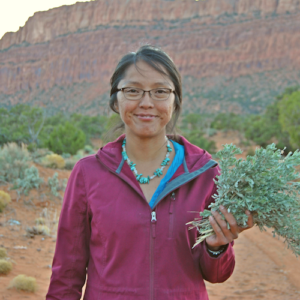Slow Food Leaders: Aretta Begay
 Aretta Begay approaches large challenges with a grassroots mindset. She tackles big issues like food sovereignty, advocacy and the preservation of cultural traditions with mindfulness and pragmatism. Aretta is the director of Diné Be’iiná (Navajo Lifeways) and the co-coordinator of the Navajo-Churro Lamb Presidium. These are two organizations with a similar mission: to bring awareness to the Navajo-Churro sheep breed and preserve traditional Navajo lifeways.
Aretta Begay approaches large challenges with a grassroots mindset. She tackles big issues like food sovereignty, advocacy and the preservation of cultural traditions with mindfulness and pragmatism. Aretta is the director of Diné Be’iiná (Navajo Lifeways) and the co-coordinator of the Navajo-Churro Lamb Presidium. These are two organizations with a similar mission: to bring awareness to the Navajo-Churro sheep breed and preserve traditional Navajo lifeways.
Preserving a pastoral way of life
The Presidium seeks to ensure a viable income for Native shepherds, many of whom are elders and some of whom have young apprentices, through the establishment of a market for sheep meat in the area. Aretta describes the Navajo Reservation as a food desert, with only 13 grocery stores in a vast area, so access to healthy foods is a huge challenge and many residents resort to eating junk food. The Presidium hopes to reinvigorate traditional ways of eating through shepherding and collecting from the land for a healthier, more nutritional way of life.
Celebrating Navajo fiber arts
Diné Be’Iiná or Navajo Lifeways takes a complementary approach to the work of the Presidium by celebrating fiber arts. Traditionally, no parts of the Navajo-Churro sheep were wasted, and the wool of the sheep was used by elders in weaving. Aretta’s work helps people understand that everything they use from the sheep comes full circle and all is sustainable.
Together, the two organizations are reviving ancestral Navajo breeds and lifeways by improving the breeding stock of flocks and encouraging awareness of fiber arts. Aretta refers to these related approaches as “sheep to table” (educating her community about the harvest of free-range sheep and the foraged herbs used by her ancestors) and “sheep to loom” (use of sheep wool in the fiber arts).
Aretta has been involved with community organizing for the last 10 years. While she grew up with sheep and horses, she didn’t know much about Navajo-Churro sheep or about fiber arts until getting involved. She has found her learning process a very eye-opening journey. That journey includes learning about sheep health, grazing habits, shearing practices, setting up a loom, and plants and dying practices.
“It is really important to us as Navajos to be raising sheep and doing plant walks. These [practices] are slowly being lost or momentum for them is being lost, but we want to see these practices go forward. Pastoralism is a major focus for us, both historically and continuing into the future.”
““Everyone should be mindful of the history of food. So many American foods stem from wild edible native American foods.”
This season, aside from turkey and ham, Aretta is thinking about ways to prepare Churro sheep meat for her holiday table. Two of her favorite dishes that will undoubtedly appear are sheep meat stewed with beans and Navajo blood sausage prepared with blue cornmeal and vegetables.
An “electrifying social movement”
Aretta remembers her first Terra Madre a decade ago and describes encountering the social movement as “electrifying.” Having been raised in the cultural milieu of the reservation, she thought a lot about how best to present herself at that first gathering. But once she arrived, she found herself immersed in the Slow Food movement, everyone connecting over foods, at pop-up dinners, watching videos or poring over books and magazines. She recalls the strength and dedication of the people who came to Terra Madre with traditional foods, advocating for a particular animal that was meaningful to them. She recalls meeting chefs full of passion for their work incorporating traditional and now-rare foods into menus. She remembers the collective impact of all the individuals who had made the effort to be at Terra Madre and the value of the exchanges and networking that took place. Aretta began with Slow Food as a youth leader and is slightly surprised to now find herself, 10 years later, as a central leader in the movement.
Sharing wisdom
Aretta says that perhaps those who benefit the most in Slow Food are those just starting out, who want to network or learn to start a small business or a gardening group. She now recognizes that the Navajo-Churro Sheep presidium was one of the pioneers, a founding presidium, and she is now in the position to help give advice and pass on knowledge to others.
Aretta cites other Indigenous food leaders she has known from the beginning, like Sean Sherman and Brian Yazzie, and says with a mix of astonishment and pleasure, “Native American food is now a trend!”
American food is Native American food
Looking to the future, Aretta hopes that people are more aware of where they get their food, that more Americans understand the work that goes into the productivity and sustainability of food and agricultural practices: “Everyone should be mindful of the history of food. So many American foods stem from wild edible native American foods. That’s what I’m thinking about.”
Aretta cites a fellow Indigenous food leader’s comment about passing on the torch: “Winona LaDuke talks about the next generation to take over the movement. Younger leaders are taking up the mantle of Slow Food and leading the movement into the future.”

